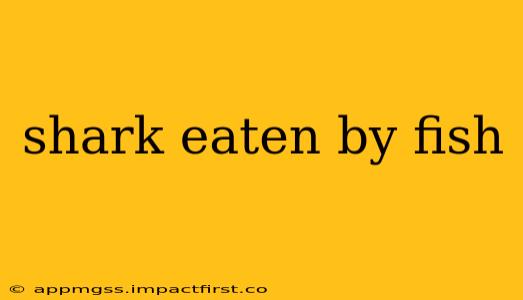While the image of a shark as the apex predator is deeply ingrained in our collective consciousness, the reality is more nuanced. While sharks are at the top of the food chain in most marine ecosystems, there are instances where they become prey. The idea of a shark being eaten by a fish might seem improbable, but it does happen, albeit rarely. This article explores the circumstances under which such an event might occur, dispelling common myths and delving into the fascinating world of marine predation.
What Kind of Fish Could Eat a Shark?
The size and species of the shark are crucial factors in determining whether it could become prey. Smaller shark species are more vulnerable than larger ones. Several large fish species are capable of preying on sharks, depending on the size of the shark and the circumstances. These include:
- Larger sharks: Yes, even larger sharks can prey on smaller shark species. Cannibalism is well-documented in several shark species.
- Groupers: Certain large grouper species, known for their powerful jaws and ambush predation techniques, are capable of taking down smaller sharks.
- Oceanic sunfish (Mola mola): While primarily planktivorous, the massive size of the ocean sunfish means it could potentially consume smaller sharks, though this is extremely rare and largely unconfirmed.
- Other large predatory fish: Depending on the circumstances and the size of the shark, other large predatory fish such as some species of tuna, billfish, and even exceptionally large groupers could potentially consume smaller sharks, especially if they are already injured or deceased.
What Are the Circumstances Under Which This Happens?
Several factors increase the likelihood of a shark becoming prey to a fish:
- Size and Age: Younger, smaller sharks are far more vulnerable than larger, adult sharks. Their smaller size makes them easier targets for larger predators.
- Injury or Illness: A weakened or injured shark is much less capable of defending itself and becomes an easier meal for other predators.
- Scavenging: While not technically predation, larger fish may scavenge on the remains of a deceased shark. This is far more common than a healthy shark being actively hunted and killed by a fish.
Can a Great White Shark Be Eaten by a Fish?
A mature great white shark, with its size and power, is highly unlikely to be consumed by another fish. Its sheer size and predatory prowess make it a formidable opponent, placing it at the very top of most food chains. However, a young, smaller great white might theoretically be preyed upon by a significantly larger shark species.
What Fish Eats a Baby Shark?
Various larger fish species, depending on the size of the baby shark, could prey on them. Many larger predatory fish, including some larger species of groupers, and other predatory fish, pose a threat.
What Eats Sharks Besides Other Sharks?
Besides other sharks, a variety of predators can potentially prey on sharks, depending on the species and size. Large marine mammals like orcas (killer whales) are well-known shark predators, while some large bony fish species can prey on smaller sharks.
Evidence and Documentation
Direct observation of a shark being eaten by a fish is rare, primarily due to the relative infrequency of the event and the challenges of observing deep-sea ecosystems. Most evidence comes from stomach content analysis of larger predatory fish and from anecdotal accounts from divers and marine biologists.
Conclusion
While not a common occurrence, the possibility of a shark being consumed by a fish is a real one. The size and health of the shark, the size and predatory capabilities of the fish, and circumstantial factors such as scavenging all play a crucial role. Understanding these factors helps shed light on the complex dynamics of marine ecosystems and the rarely observed intricacies of predator-prey relationships. The rarity of this event, however, reinforces the shark's typical position at the top of its food web.
